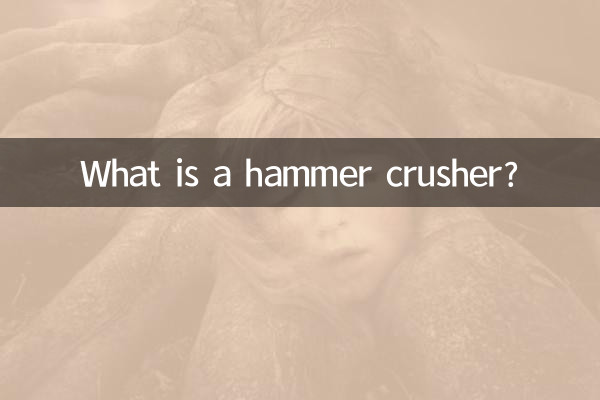What is a hammer crusher?
In industrial production and mining, crushing equipment is an indispensable and important tool. As an efficient crushing machine, hammer crusher is widely used in building materials, metallurgy, chemical industry, electric power and other industries. This article will introduce in detail the definition, working principle, structural characteristics, application fields and popular models of the hammer crusher to help you fully understand this equipment.
1. Definition of hammer crusher

Hammer crusher is a mechanical equipment that uses a high-speed rotating hammer head to impact and crush materials. Its core features are large crushing ratio, high production efficiency and low energy consumption. It is suitable for crushing medium hardness and brittle materials.
2. Working principle
The working principle of the hammer crusher is that the motor drives the rotor to rotate at high speed. The hammer on the rotor strikes, impacts, shears and grinds the materials entering the crushing cavity under the action of centrifugal force, so that the materials reach the required particle size.
| working stage | describe |
|---|---|
| Feed | Material enters the crushing cavity through the feed port |
| broken | The high-speed rotating hammer head impacts and crushes the materials. |
| Screening | The crushed materials are discharged through the sieve plate, and the materials that do not meet the standards continue to be crushed. |
3. Structural characteristics
Hammer crusher mainly consists of the following components:
| Part name | Function description |
|---|---|
| chassis | Protect the internal structure and prevent materials from splashing |
| rotor | Carrying the hammer head and providing rotational power |
| hammer head | Direct contact with materials for crushing operations |
| Sieve plate | Control discharging particle size |
| Transmission | Transmits the power of the motor to the rotor |
4. Application areas
Hammer crushers are widely used in many industries due to their excellent performance:
| industry | Application Notes |
|---|---|
| cement industry | Used for crushing limestone, gypsum and other raw materials |
| Metallurgical industry | Processing of ores, slag and other materials |
| Chemical industry | Crushing various chemical raw materials |
| Electric power industry | Used for crushing coal |
| Building materials industry | Processing of sand and gravel aggregates for construction |
5. Popular models in the market
According to recent market research, the following are several popular hammer crusher models and their main parameters:
| model | Production capacity(t/h) | Motor power (kW) | Feed particle size (mm) | Discharge particle size (mm) |
|---|---|---|---|---|
| PCZ1512 | 150-300 | 250 | ≤800 | ≤35 |
| PCZ1615 | 200-350 | 315 | ≤1000 | ≤40 |
| PCZ1820 | 300-500 | 400 | ≤1200 | ≤50 |
6. Advantages of hammer crusher
Compared with other types of crushers, hammer crushers have the following significant advantages:
1.Large crushing ratio: Generally it can reach 10-25, or even higher, which can crush large pieces of materials to the required particle size at one time.
2.Simple structure: Few parts, easy maintenance and low operating cost.
3.Low energy consumption: 30%-50% more energy-saving than traditional crushers.
4.Adaptable: It can handle materials with high moisture content and is not easy to get clogged.
5.Uniform particle size: The discharge particle size can be precisely controlled by adjusting the sieve plate gap.
7. Purchase suggestions
When choosing a hammer crusher, the following factors should be considered:
1.Material properties: Including hardness, humidity, mud content, etc.
2.Yield requirements:Choose the appropriate model according to production needs.
3.Discharge particle size: Ensure that the equipment can meet the particle size requirements of the final product.
4.Equipment quality: Choose a well-known brand to ensure the service life and maintenance cost of the equipment.
5.After-sales service: Consider the supplier’s after-sales service capabilities.
8. Maintenance
In order to ensure the long-term stable operation of the hammer crusher, the following maintenance work should be done:
| maintenance items | cycle | content |
|---|---|---|
| daily inspection | every day | Check lubrication condition and fastener condition |
| Hammerhead inspection | weekly | Check for wear and replace in time |
| Comprehensive maintenance | quarterly | Check key components such as bearings and screen plates |
9. Future development trends
With the advancement of industrial technology, hammer crushers are developing in the following directions:
1.Intelligent: Equipped with sensors and control systems to achieve remote monitoring and automatic adjustment.
2.Energy saving and environmental protection: Reduce energy consumption, reduce dust and noise pollution.
3.Large-scale: Improve the processing capacity of a single machine to meet the needs of large-scale production.
4.Multifunctional: Adapt to the crushing needs of more types of materials.
5.Material innovation: Use more wear-resistant materials to extend the service life of wearing parts.
Through the above introduction, I believe you have a comprehensive understanding of hammer crushers. This equipment plays an important role in industrial production. The correct selection and rational use of hammer crushers will greatly improve production efficiency and reduce production costs.

check the details

check the details